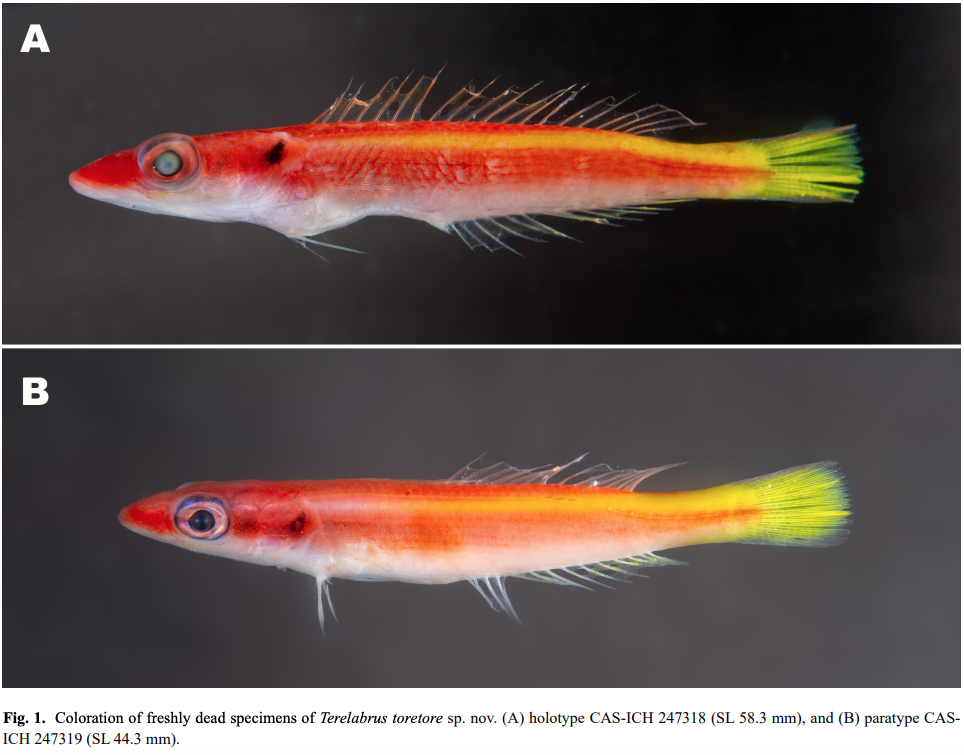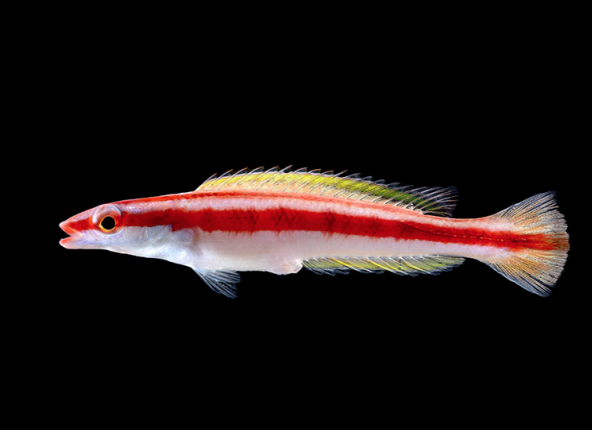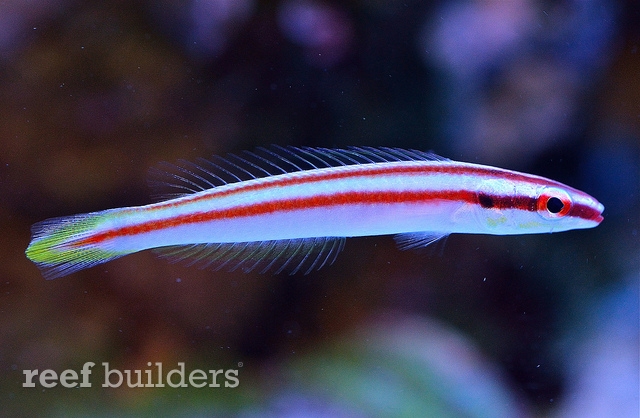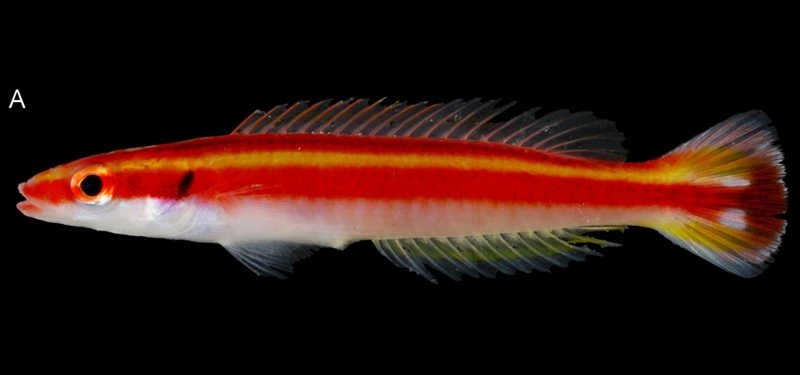[ad_1]
A new species of deepwater hogfish has been described in the journal Zoological Studies. Terelabrus toretore is now the fifth species within the genus Terelabrus, and was discovered in the mesophotic zone in Tahiti, French Polynesia. Mesophotic zones range from 100-490 feet, and represent the lower limits for most photosynthetic corals as well for divers. Specialist rebreather diving equipment and trained technical divers are necessary for depths over 200 feet. T.toretore was collected at a staggering 140m/459’ by a team including well-known deep diving Ichthyologist Luis Rocha, of the California Academy of Sciences. The paper was authored by Bart Shepherd, Hudson T. Pinheiro, Tyler A. Y. Phelps, Gilles Siu, and Luis Rocha.

The four other species of Terelabrus also come from mesophotic reefs, at depths from 50-150m/164-492′. The first member of the genus, T.rubrovittatus was caught in New Caledonia and described in 1998. The second species, T.dewapyle, arrived in 2015 and was described from five specimens collected in southern Japan, Papua New Guinea, and Fiji. Terelabrus flavocephalus came in 2016 from the Maldives, and Terelabrus zonalis came in 2018 from the Philippines, coming by way of a trawl.
In 2019 the team collected two specimens of a suspected new species of Terelabrus from French Polynesia, followed by what later turned out to be T.rubrovittatus from the Marshall Islands – a range extension for that species. T.zonalis was also found in Australia for the first time – another range extension when the first was found in the Philipines, and the new species is now named in this paper as Terelabrus toretore, from the Tahitian word for striped.

Terelabrus are small, fast swimming labrid fishes, according to the authors, characterized by an elongated, cylindrical body, large eyes and a body coloration typically consisting of alternating longitudinal stripes of red and yellow or white, which extend along the full length of the body.
Differences include the number of scale rows in longitudinal series, the number of gill rakers, the number of posterior branches of the main supratemporal sensory canal, and color. The paper says that, as with numerous other new fishes that have been recently described from deep reefs, these species have been described using only a single or small number of specimens but are likely common in their habitat.
We asked Bart Shepherd, Senior Director at the Steinhart Aquarium, and lead author on the new description more about this discovery:

Can you describe the habitat for Terelabrus toretore and its congeners?
Most of the deep reefs that we dive on are very structured, rocky environments, with lots of small caves and crevasses. The invert fauna is highly variable – sometimes we find every available surface covered with encrusting organisms, sponges, black corals, wire corals, gorgonians, etc. Other reefs are less diverse with more exposed rock. I’m not sure what the pattern is, but it is not always related to depth. That is, the places we visit don’t always get less biodiverse and richly populated the deeper we go. Sometimes the deepest parts are the most beautiful and diverse.
Do you target unexplored areas when looking for new fish, or do reports of new fish make you visit those areas?
Both! We have specifically visited areas where ROV work has revealed several undescribed fishes- for example, Rapa Nui (Easter Island), from where we have described 5 or 6 new species found on just a pair of deep dives. We also had the benefit of some ROV scouting in French Polynesia, including the screen grab of Terelabrus toretore that appears in this paper. Other times we know we are the first people looking at these habitats. We have a wonderful new partnership in the Maldives that is yielding great results. There is no decompression diving allowed in the entire nation, so we have received special permission to do this work and are the first people seeing any of these reefs. It’s very exciting.

Which mesophotic zones are particularly hot for new fish species right now? Where is next on your list to explore?
The Maldives is a current area of focus. We’ve found maybe 10-12 new species of deep reef fish on a couple of trips. I’m hoping we will get back there in October to continue this work. I’m basically excited to go anywhere in the Indian Ocean, as the mesophotic zone there is largely unexplored. Our biggest challenge is getting the right dive support – including an operational hyperbaric (recompression) chamber for our own safety. We’ve got some other trips tentatively planned with partners in Chile and New Zealand, so hopefully, we will get there soon. And of course the Galapagos. The Academy has a long history of partnership and research in the Galapagos, and no one has really explored the mesophotic there. I’m sure it would be cold, but it should be amazing!
Do you think any Terelabrus will make their way into the aquarium trade? T.rubrovittatus looks lovely!
That’s a great question. They are obviously below the reach of most collectors. We see occasional dribbles of fishes from mesophotic reefs into the aquarium trade, so I think it is possible. And we of course don’t know the extent of their natural ranges – they likely occur far outside of the few locations where they have been documented.

How do Terelabrus live together in the wild? Do they form pairs? Are they aggressive and territorial to each other and other species?
We always see them as individuals. We might see several on a single dive, but they don’t school or form pairs as far as I have seen. It’s really hard to extrapolate behavior from the few short minutes that we have on the bottom, so I honestly can’t say how they interact with each other or with other fishes.
What challenges do you face when diving the mesophotic zone?
So many! Time is one of the biggest ones. We have such a short time down there – 10 to 20 minutes, usually. And we are so task-loaded: managing the rebreather, monitoring the other members of the team, looking for fish, watching the decompression time build up. It takes so much mental energy to stay on top of all of this while we are under such immense pressure – literally and figuratively! And then on top of all of that, go try and catch a fish with hand-nets. It is all really challenging, and when the fish gets away it can be very frustrating.

What are you working on right now, and what trips do you have planned for the future?
As I mentioned, the Maldives is a big area of focus. We also have been developing a partnership with the Roatan Marine Park in Roatan, Honduras. I’m excited about that as well. We’ve got 10-12 new species of fishes from our recent trips that need to be named. And 29 September 2023 is the 100th anniversary of the opening of Steinhart Aquarium, so we’re working on plans to celebrate that later in the year. So I’m very busy with my role as Director of Steinhart Aquarium as well as co-leading the Academy’s Hope for Reefs initiative.
[ad_2]
Source by [author_name]



